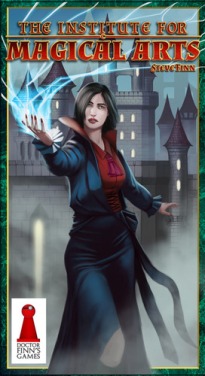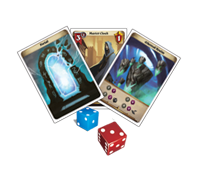The Institute for Magical Arts is a game by Steve Finn, published by Dr. Finn’s Games. It is for 2 players. In this game, players will take on the role of wizards that are trying to each gain the title of headmaster of the Institute. They will employ magical powers to win over their colleagues and collect various tools to help them on their way. The player that can harness their magical energies the best will be declared the winner.
To begin, players choose either blue or red and take the corresponding action cards, scoring marker, dice, score card and 5 small power stones of that color. Player then are given 3 re-roll cubes, 2 small charm cubes and a phase card. The rest of the power stones and charm cubes are placed off to the side within reach of both players. The 2 copies of Novice Crystal Ball, Mortar and Pestle and Ring of Influence are taken out of the Institute cards. These cards are then shuffled together and each player is dealt 1 card. The remaining cards are placed back with the other Institute cards. Players place the card face up in front of them as a starting card. Players place their scoring marker on their score card on the “3” space. The 6 location cards are placed in a row in numerical order. The Ethereal Realm card is placed at the end of this row. The deck of Institute cards are shuffled together. 1 card is dealt out face up to each of the first 5 location cards. The portal card is placed beside location 6. The remaining deck of cards are placed next to the ethereal realm card. Players set up their play area and play now begins.
The game is played in a series of rounds that consist of 5 phases; assign action cards to dice, take and cast power stones, use the portal, trigger permanent powers, award institute cards. These phases are repeated on the phase card that each player received earlier. The first phase is to assign action cards to dice. In this phase, players will plan out which actions they want to take later based on their dice roll. They begin by rolling their 4 dice and then placing them next to the location card of the same number. They then choose an action card from their hand and place it facedown below the die. The cards that a player can use allow them to either take stones, cast 2 stones or cast 1 stone. The card that takes stones allows the player to collect a number of power stones equal to the die chosen. Power stones are how players gain influence over the different Institute cards. The card that casts 2 stones allows a player to place 2 power stones on the corresponding card while the card that casts 1 stone only allows 1 stone to be placed. If a player rolls less than 6 points total combined on their 4 dice, they are allowed a free re-roll. If a player doesn’t like their roll, they can use one of their re-roll cubes to re-roll any or all of the dice. The player is allowed to refill their re-roll cubes by returning a charm cube to the supply. This will lower a player’s points by 1 as charm cubes are worth 1 point each. Once both players are satisfied with their card selections, they verbally acknowledge that they are done. Players will then reveal their action cards simultaneously.
The second phase is to take and cast power stones. These 2 steps must be completed in order. The first thing that is done is to take stones, if possible. Players check to see if either of their 2 take stone action cards were played. If so, they will take the number of stones equal to the die that they placed the card beside from the general supply. The next thing that is done is to cast power stones. Players assign either 1 or 2 power stones determined by the action card played to the adjacent Institute card. The power stones are taken from the player’s personal supply and placed on the card. If the player has no power stones, no stones may be placed.
The third phase is to use the portal. The portal allows a player to either shift power stones to an institute card or to the ethereal realm card. The player must decide if they would like to move all of their power stones to an institute card of their choice, or they can move only 1 stone to the Ethereal Realm card, leaving any remaining stones on the portal. However if both players have power stones on the portal, they must secretly decide what they want to do. Each player takes an action card and a die. The card is used to hide their die. The player then chooses a value to show what they want to do, matching either the institute card or portal by the value of the location card. Only 1 player may have power stones on the ethereal realm card. If a player moves one of their stones to the ethereal realm and the other player already has a stone there, both players lose their stone and place it back in the general supply. If a player has 1 or more stones left on the card, they can either claim the corresponding reward or they can leave it there to try and claim a higher reward later.
The fourth phase is to trigger permanent powers. Players check their cards to see if they would like to activate any of their cards that are uniquely numbered. To activate the card, the player must pay 1 power stone to the general supply. Once players have either activated or passed, the final phase can begin.
The final phase is to award institute cards. This is done by checking each of the face up institute cards that have power stones on them. Players look to see if the requirements have been met both in the number of power stones that a player must have on the card and the number of power stones that the player must exceed the other player by. If both requirements are met, the player wins the institute card placing it face up in front of them. The power stones are returned to the general supply and the player adds the victory points awarded them by the card to their score card. Once all the locations have been checked and Institute cards awarded, players check to see if either player has 20 points or more. If not, any empty locations are filled by shifting the remaining cards towards the 1 location filling in each place. They will then draw a new card and fill any remaining open locations with a new card. If the portal shifts down to location 1, it is temporarily removed and the remaining cards are shifted down. The portal is then placed at location 6 and any power stones on it are removed. A new round then begins. This continues until a player reaches 20 or more victory points. Once that happens the game is over. The player that reaches 20 points wins. In case of a tie, the player with the most points wins.
COMPONENTS
Just like all of Dr. Finn’s games, this game has some really great pieces to it. All of the different cards look really great. The artwork for the Institute, Portal and Ethereal Realm cards are especially nice. They have that Harry Potter/Hogwarts feel to them. I absolutely love the look. All of the different stones, markers and cubes are nice wooden pieces that are brightly colored. They look really nice and feel like high quality components. The score cards have nice big numbers on them which are good for those with failing eyesight, like myself. The dice are nice and brightly colored as well. There’s even a nice little pamphlet that details the cards. Everything looks really great and fits in with the theme quite well. As usual, I’m impressed with the product.
9 out of 10
RULEBOOK
The rulebook is nicely designed. It has lots of great examples throughout the book. There are some nice pictures as well, basically showing how the game setup should look and explaining certain examples. Each phase of the game is thoroughly covered in great detail. There is also a small section dedicated to variants in gameplay. There’s even a nice game summary on the last page. There is nothing that is difficult to understand. The book is very easy to read. The cover photo reminds me a lot of Professor Snape from the Harry Potter books. Everything looks good here and is well done.
9 out of 10
GAMEPLAY
This game is an area control game at heart. It’s all about getting your influence on the Institute cards before the other player can as you try to score points faster than your opponent. Each card will help you earn more points but what’s even better is the powers that they will give you. I really like using the portal as it can help you gain a lot of points pretty quickly as long as your opponent doesn’t knock off your power stones. Yes the game is quite luck based. You will have no control over what the dice do. What you CAN control is how you use what you are given. If you want to get a lot of power stones, use that 5 you just rolled to take stones. Your opponent is making a run on a particular card, use the place 2 stone card to slow them down a bit. It’s quite strategic in that way. You can easily find yourself overthinking things sometimes, which is what I did quite a bit. If that happens the game is gonna take a bit longer than the 30 minute suggested playing time. The main thing is to just go with your gut, read your opponent and move on. Once I realized that, things went a bit faster. The theme is really nice and comes through rather subtly. I really enjoyed it and found it to be a nice filler game.
9 out of 10
OVERALL
The Institute for Magical Arts is a light weight game of area control in the wizarding world. It is a very enjoyable game that can be played in a little over 30 minutes. However if players are prone to analysis paralysis, it may take a bit longer. The artwork is really nice and has a great Harry Potter type theme to them. The game is quite simple to play and is fairly easy to learn. Even though it has a lot of luck involved, the strategic part of the game more than makes up for it. Fans of previous Dr. Finn games will love this, as should anyone that likes area control games. This is a great filler game and one that I like quite a bit. I highly recommend it. Professor Snape would be proud.
9 out of 10

For more information about this and other great games, please check out Dr. Finn’s Games at their site.



